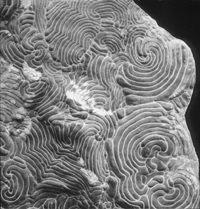Long before the dinosaurs ruled Earth, the planet was populated by tiny, wriggling creatures that left behind traces of their passage in the form of elaborate swirls and other patterns permanently preserved in stone. Examples of these and other "artworks" created by nature -- including an original specimen showing the tracks of what may be the oldest known form of animal life on earth -- will be featured in a new exhibit titled "Fossil Art," which will be on display Nov. 12-Jan. 3 at the Peabody Museum of Natural History.
"Fossil Art" is the brainchild of Adolf Seilacher, adjunct professor of geology and geophysics and curator-in-charge of the exhibit. Through his research, Seilacher seeks to understand the interplay between extinct organisms and the environ-
The exhibit seeks "to bridge the deeply rooted cultural divide between arts and sciences," writes the Yale scientist in the catalogue accompanying the display. "If we manage ... to also stimulate new interest in Earth History -- even better."
"Fossil Art" incorporates a number of themes. It looks at life on earth before and after the "Cambrian explosion," the era 545 million years ago when a wide variety of organisms originated and left their mark on the fossil record. It reveals how artistic nature's handiwork can be, and delineates the differences between the stone markings left by the elements and those left by biological organisms. It also shows how the field of fossil-hunting has been changed by new technologies that allow accurate casts to be made on-site.
One highlight of the exhibit is an original fossil specimen found recently by Seilacher and his colleagues in the sandstone formations of the Son Valley in Central India. The specimen features "trace fossils" (i.e., preserved burrows or tracks), which the scientists believe were created by small, worm-like creatures 1.1 billion years ago -- making the fossil twice as old as any other evidence for multicellular life yet discovered. The scientists announced their discovery in October in the journal Science. (See the Oct. 5-12 issue of the Yale Bulletin
The other objects on display in "Fossil Art" are casts made directly from what were once the sea beds where primitive organisms lived millions of years ago. Seilacher notes in the catalogue that, in recent years, making such casts on-site has replaced the former practice of excavating fossils and shipping them to to research facilities.
"Silicon or latex rubber casts are of such outstanding quality nowadays, that they can be examined with an electron microscope," writes Seilacher, who is also adjunct curator of invertebrate paleontology at the Peabody. "They roll up like carpets for easy transport, and there is no limit to the number of reproductions. ... Such casts are not only transportable, they also show the fossils in their original association and, with controlled lighting, the image of the ancient sea bottoms comes out better than in the field."
One section of the exhibit, titled "Nature as Fingerpainter," focuses on the elaborate symmetries that can be found in nature -- from zebra stripes to wave patterns to animal tracks. "So where is the limit?" asks Seilacher in the catalogue. "Are you an artist when your hand creates patterns in the glass panel? Were the Chinese masons artists when they used a self-organizing process to produce a pleasing design? Should the definition of art not be based on perception as well as on fabrication? ... Couldn't this natural sculpture claim a similar price as the work of a human artist?"
The Peabody Museum will host three special programs in conjunction with "Fossil Art." Seilacher will present a talk titled "The Earliest Life: What We Think We Know" at 4 p.m. on Friday, Nov. 13. This lecture will be followed by an informal tea. The geologist will join School of Art Dean Richard Benson and other Yale scholars for a panel discussion titled "Fossil Art, Found Art and Art" at 4 p.m. on Monday, Nov. 16. This event, too, will be followed by refreshments. Finally, Seilacher will give a guided tour of the "Fossil Art" exhibit at 1:30 p.m. on Saturday, Dec. 5. A book signing will follow the tour. All three events are free with museum admission.
The Peabody Museum of Natural History is located at 170 Whitney Ave. It is open 10 a.m.-5 p.m. Monday-Saturday and noon-5 p.m. on Sunday. For information on admission and parking, call the InfoTape at 432-5050 or visit the museum's website at www.peabody.yale.edu.
ment in which they lived from clues found in the geological strata. For his work, the scientist has been awarded the highest honor that can be bestowed on a geologist: the Crafoord Prize of the Royal Swedish Academy of Scientists.
& Calendar.)

PHOTO BY WILLIAM K. SACCO
| This limestone cast from the "montenovo" quarry at Wes- tersletten, Germany, shows wave ripples created during the Jurassic period. It is one of 26 objects on view in "Fossil Art."
| |
 November 9-16, 1998
November 9-16, 1998